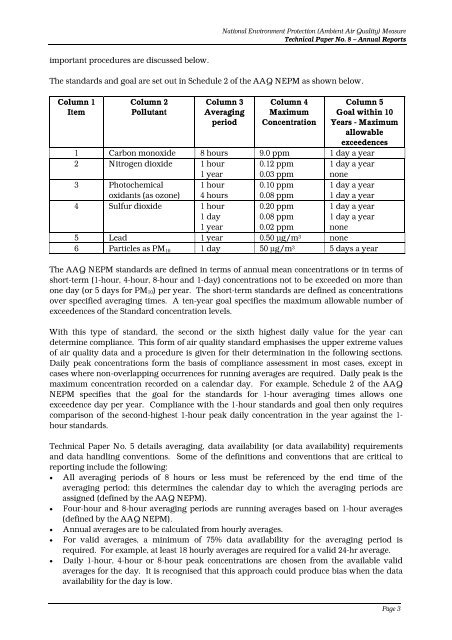Technical Paper No 8 - Annual reports for the AAQ NEPM
Technical Paper No 8 - Annual reports for the AAQ NEPM
Technical Paper No 8 - Annual reports for the AAQ NEPM
- No tags were found...
Create successful ePaper yourself
Turn your PDF publications into a flip-book with our unique Google optimized e-Paper software.
National Environment Protection (Ambient Air Quality) Measure<strong>Technical</strong> <strong>Paper</strong> <strong>No</strong>. 8 – <strong>Annual</strong> Reportsimportant procedures are discussed below.The standards and goal are set out in Schedule 2 of <strong>the</strong> <strong>AAQ</strong> <strong>NEPM</strong> as shown below.Column 1ItemColumn 2PollutantColumn 3AveragingperiodColumn 4MaximumConcentrationColumn 5Goal within 10Years - Maximumallowableexceedences1 Carbon monoxide 8 hours 9.0 ppm 1 day a year2 Nitrogen dioxide 1 hour1 year0.12 ppm0.03 ppm1 day a yearnone3 Photochemicaloxidants (as ozone)1 hour4 hours0.10 ppm0.08 ppm1 day a year1 day a year4 Sulfur dioxide 1 hour1 day1 year0.20 ppm0.08 ppm0.02 ppm1 day a year1 day a yearnone5 Lead 1 year 0.50 µg/m 3 none6 Particles as PM 10 1 day 50 µg/m 3 5 days a yearThe <strong>AAQ</strong> <strong>NEPM</strong> standards are defined in terms of annual mean concentrations or in terms ofshort-term (1-hour, 4-hour, 8-hour and 1-day) concentrations not to be exceeded on more thanone day (or 5 days <strong>for</strong> PM 10) per year. The short-term standards are defined as concentrationsover specified averaging times. A ten-year goal specifies <strong>the</strong> maximum allowable number ofexceedences of <strong>the</strong> Standard concentration levels.With this type of standard, <strong>the</strong> second or <strong>the</strong> sixth highest daily value <strong>for</strong> <strong>the</strong> year candetermine compliance. This <strong>for</strong>m of air quality standard emphasises <strong>the</strong> upper extreme valuesof air quality data and a procedure is given <strong>for</strong> <strong>the</strong>ir determination in <strong>the</strong> following sections.Daily peak concentrations <strong>for</strong>m <strong>the</strong> basis of compliance assessment in most cases, except incases where non-overlapping occurrences <strong>for</strong> running averages are required. Daily peak is <strong>the</strong>maximum concentration recorded on a calendar day. For example, Schedule 2 of <strong>the</strong> <strong>AAQ</strong><strong>NEPM</strong> specifies that <strong>the</strong> goal <strong>for</strong> <strong>the</strong> standards <strong>for</strong> 1-hour averaging times allows oneexceedence day per year. Compliance with <strong>the</strong> 1-hour standards and goal <strong>the</strong>n only requirescomparison of <strong>the</strong> second-highest 1-hour peak daily concentration in <strong>the</strong> year against <strong>the</strong> 1-hour standards.<strong>Technical</strong> <strong>Paper</strong> <strong>No</strong>. 5 details averaging, data availability (or data availability) requirementsand data handling conventions. Some of <strong>the</strong> definitions and conventions that are critical toreporting include <strong>the</strong> following:• All averaging periods of 8 hours or less must be referenced by <strong>the</strong> end time of <strong>the</strong>averaging period; this determines <strong>the</strong> calendar day to which <strong>the</strong> averaging periods areassigned (defined by <strong>the</strong> <strong>AAQ</strong> <strong>NEPM</strong>).• Four-hour and 8-hour averaging periods are running averages based on 1-hour averages(defined by <strong>the</strong> <strong>AAQ</strong> <strong>NEPM</strong>).• <strong>Annual</strong> averages are to be calculated from hourly averages.• For valid averages, a minimum of 75% data availability <strong>for</strong> <strong>the</strong> averaging period isrequired. For example, at least 18 hourly averages are required <strong>for</strong> a valid 24-hr average.• Daily 1-hour, 4-hour or 8-hour peak concentrations are chosen from <strong>the</strong> available validaverages <strong>for</strong> <strong>the</strong> day. It is recognised that this approach could produce bias when <strong>the</strong> dataavailability <strong>for</strong> <strong>the</strong> day is low.Page 3
















